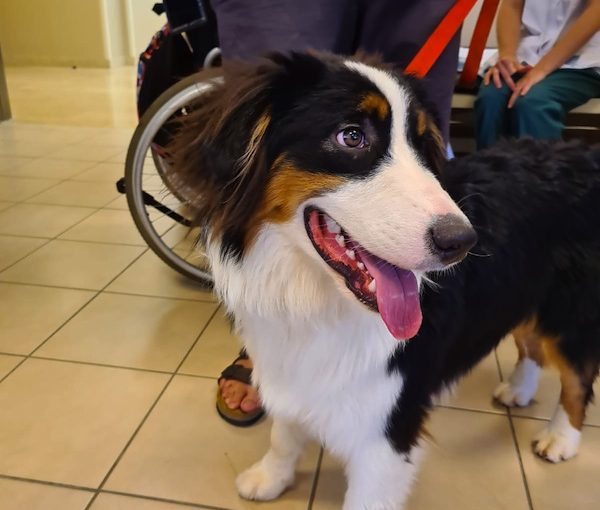Sheba is a trained physiotherapy dog. One of the patients he’s helping at Sheba Medical Centre is Nathaniel Felber, who suffered a head injury in a terror attack in December 2018. (photo from IMP)
Nathaniel Felber is an Israel Defence Forces soldier who suffered a critical head injury in a terror attack in December 2018. He has been slowly recovering, against all odds. After being in a coma for several months, he was moved to Sheba Medical Centre, where he’s been receiving intensive rehabilitation. After a brief setback following brain surgery last May, Felber has made remarkable progress, and a lot of the credit goes to Sheba – not only the hospital but its namesake, a trained physiotherapy dog.
“The dog relates to Nathaniel in a nonjudgmental way, happily accepting the food that Nathaniel offers or any other attention,” said Judi Felber, who has been at her son’s side almost constantly since the attack that upended their lives.
Prof. Israel Dudkiewicz, who heads Sheba’s orthopedic rehabilitation program, has noted a marked improvement in compliance, strength and endurance in patients like Felber, when performing physical therapy exercises with the dog.
“The dog takes attention away from the pain and difficulty of the exercise, enabling the patient to try to do more and to do it better,” explained Dudkiewicz. “I’ve watched patients who ordinarily wouldn’t be able to stand for just two or three minutes, but, when they pet the dog, they can be standing for 30 minutes and more without even realizing it.”
Felber builds strength and balance in his legs by standing and petting Sheba. He also throws a ball for the dog to retrieve, a game that repeatedly flexes his elbow, but without the tedium of the standard physio exercises for the same purpose. When brushing Sheba, Felber must exert enough pressure to run the brush through the dog’s fur, but not too much that would cause him pain.
The Felbers made aliyah from Silver Spring, Md., about 14 years ago, settling in Ra’anana with their three children and a dog. “Nathaniel loved our dog, and I think that interacting with Sheba the dog is very healing for him,” said his mother.
Dudkiewicz is delighted with Felber’s positive response to Sheba, as well as the responses of patients working with therapy dogs in general.
“We have seen dramatic improvement in patients performing physical therapy with dogs from both a physical and emotional perspective,” he said. “We aim to incorporate this as another treatment tool, such as hydrotherapy and other nonconventional therapies, for patients who can benefit from it.”
At just seven months old, Sheba is still a puppy, but his performance thus far points to a successful future. Dogs used in physical therapy must undergo a yearlong, rigorous training period. The staff must likewise be trained how to integrate the dog into their rehab programs. In the course of training, the dogs are tested periodically to see that they’re up to scratch. Dudkiewicz explained that different dogs are trained for different types of patients and their abilities. The cost of each dog, including training, is more than $30,000, meaning that its implementation in the department must be limited; however, Dudkiewicz said the results certainly justify the financial outlay.
“Neurorehabilitation is slower than anything else I’ve ever experienced,” said Judi Felber. “Nathaniel is not walking, or talking, or eating even independently – yet. But I try to focus on the positive: he’s responding to people, to us, his family. He’ll turn his head and give us his hand. He can nod yes and no and show us the number of fingers that we ask. We’ve still got a long way to go, but I’m hopeful.”
– Courtesy International Marketing and Promotion (IMP)

